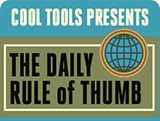A cool tool can be any book, gadget, software, video, map, hardware, material, or website that is tried and true. All reviews on this site are written by readers who have actually used the tool and others like it. Items can be either old or new as long as they are wonderful. We post things we like and ignore the rest. Suggestions for tools much better than what is recommended here are always wanted.
Tell us what you love.Categories
- Announcements
- Aural
- Autonomous Motion
- Backpacking
- Big Systems
- Clothing
- Communications
- Community
- Computers
- Consumptivity
- Craft
- Culture
- Dead Tools
- Deals
- Design
- Destinations
- Dwelling
- Edibles
- Every Day Carry
- Family
- Gardens
- Gareth's Tips
- General Purpose Tools
- Health
- Homestead
- Inner Space
- Just 1 Question
- Kitchen
- Learning
- Life on Earth
- Livelihood
- Living on the Road
- Maker Tools
- Maker Update
- Materials
- Media Tools
- Multiple Product Reviews
- No Stream
- Nomadico
- Paper World
- Photography
- Play
- Podcast
- Prove Us Wrong
- Readers' Gifts
- Recomendo
- Related Stuff
- Science Method
- Somatics
- Source Wanted
- Tips
- Tool Chest
- Tools for Possibilities
- Uncategorized
- Vehicles
- Videos
- Visual Media
- What's in My Bag
- Workplace
- Workshop
Useful Traveler Gifts
At this time of year, publications are flooded with gift ideas, including ones supposedly for travelers that nobody boarding a plane will actually make room for. So each year I update this post on traveler gifts that will actually get used. These are items I pack personally, ones I see other frequent fliers carrying, and new ones that deserve their space and weight. I tend to favor inexpensive, lightweight, and small items that solve a problem. These have a better chance of taking a trip with the recipient, not tossed into a storage area at home.
Stricter Requirements for an Italian Passport
An Italian passport used to be one of the easiest ones to obtain for those who wanted a second one that came with EU movement freedom, but living la dolce vita is getting much tougher now. You must prove direct lineage no further back than a grandparent, speak Italian well enough to pass a proficiency exam, and live there already for three years to qualify. See the details here.
Cheaper Streaming Abroad
I’m going to add Apple TV at home after watching only part of Severance on a United flight, but I’ll likely subscribe in Mexico where it’s 28% cheaper than the USA. You can play this arbitrage game with most of the streaming services—I once got HBO on sale for $5 a month. In Mexico you can get the highest tier of Netflix for the price of the middle tier stateside, a 39% monthly savings (with a better studio movie selection too). Shop around if moving around. In Turkey, for example, the highest tier of Netflix with 4K hi-def is less than US$10 per month. Try regional gift cards, signing up while in another country, or using a good VPN for the first transaction.
A Long Walk Is Better Than Many Short Ones
Good news for travelers: those mountain hikes and long walks across the city are better for your health than quick spins around the block. According to research in the Annals of Internal Medicine that measured step counts over eight years, “People who walked in longer stretches had a lower risk of heart problems than those who walked in short bursts. Their risk of heart disease and death dropped significantly.” I’m linking to the explanatory article from the BBC since the source study’s title will give you an idea of how dry their version is: “Step Accumulation Patterns and Risk for Cardiovascular Events and Mortality Among Suboptimally Active Adults.”
A weekly newsletter with four quick bites, edited by Tim Leffel, author of A Better Life for Half the Price and The World’s Cheapest Destinations. See past editions here, where your like-minded friends can subscribe and join you.






